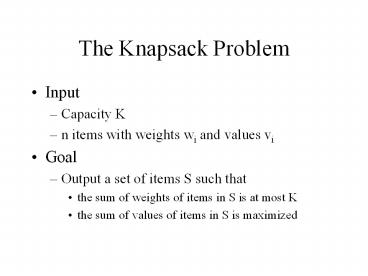The Knapsack Problem - PowerPoint PPT Presentation
1 / 7
Title:
The Knapsack Problem
Description:
Output a set of items S such that. the sum of weights of items in S is at most K ... wD = 5 vD = $95. wE = 3 vE = $30. Weight. Items. Define Subproblems Based on Value ... – PowerPoint PPT presentation
Number of Views:222
Avg rating:3.0/5.0
Title: The Knapsack Problem
1
The Knapsack Problem
- Input
- Capacity K
- n items with weights wi and values vi
- Goal
- Output a set of items S such that
- the sum of weights of items in S is at most K
- the sum of values of items in S is maximized
2
Variations
- Fractional
- You may take a fraction of the entire item
- All or nothing
- You must take all of an item or none of it
- Special cases of All or nothing
- All items have same weight (or same value)
- All items have same density (value/weight)
- For which of the above variations does a greedy
strategy work? - For which of the above variations does a greedy
strategy NOT work?
3
Dynamic Programming
- Consider the all or nothing version
- Assume that all weights/values are reasonably
sized integers - We can use dynamic programming to solve this
problem (even though there is no explicit
ordering among the items)
4
Definining subproblems
- Define P(i,w) to be the problem of choosing a set
of objects from the first i objects that
maximizes value subject to weight constraint of
w. - Impose an arbitrary ordering on the items
- V(i,w) is the value of this set of items
- Original problem corresponds to V(n, K)
5
Recurrence Relation/Running Time
- V(i,w) max (V(i-1,w-wi) vi, V(i-1, w))
- A maximal solution for P(i,w) either
- uses item i (first term in max)
- or does NOT use item i (second term in max)
- V(0,w) 0 (no items to choose from)
- V(i,0) 0 (no weight allowed)
- What is the running time of this solution?
- Number of table entries
- Time to fill each entry
6
Example
Items
wA 2 vA 40 wB 3 vB 50 wC 1 vC
100 wD 5 vD 95 wE 3 vE 30
Weight
7
Define Subproblems Based on Value
- Define P(i,w) to be the problem of choosing a set
of objects from the first i objects that
maximizes value subject to weight constraint of
w. - V(i,w) is the value of this set of items
- Original problem corresponds to V(n, W)
- Define P(i,v) to be































